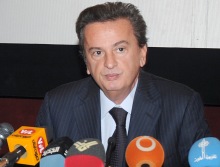 Lebanon plans to raise the minimum level of top quality capital reserves held by banks to 12 percent within seven years, the Central Bank governor said Friday.
Lebanon plans to raise the minimum level of top quality capital reserves held by banks to 12 percent within seven years, the Central Bank governor said Friday.
Riad Salameh said he originally envisaged asking banks to raise reserves of Tier 1 capital to 10 percent – already significantly higher than the 7 percent required by the Basel III package agreed by bankers and regulators last year.
But in response to the global economic crisis and European banking woes, Salameh said he had decided to hike the requirement to 12 percent, a figure he said would put Lebanese banks “among the highest in terms of capital adequacy.”
Lebanon’s banks, traditionally seen as conservative and secure operators, saw a sharp rise in inflows following the 2008 financial crisis as depositors shifted money into what they saw as a safe financial haven.
“Banks today in Lebanon have already the 7 percent required by Basel III as capital adequacy,” Salameh said in an interview in his Beirut office.
The Central Bank will issue a directive in the next 45 days setting a 10 percent target for Tier 1 capital within four years, rising to 12 percent three years later.
Salameh said he believed the target could be reached without significantly curbing the banks’ growth or lending.
“Of course it takes time … but I guess that what you are seeing today in the banking sector worldwide is encouraging them to go along this path.”
Salameh reiterated his forecast that Lebanon’s economy would grow by just 2 to 3 percent this year, after years of annual growth around 8 percent.
Political tension which brought down the government of Prime Minister Saad Hariri in January also helped bring growth crashing to a halt. “The first half of the year we had zero growth,” Salameh said.
His prediction is still above that of the International Monetary fund, which foresees 1.5 percent growth this year, and of other financial institutions, but Salameh said they may be understating the rebound since mid-year.
He declined to give a forecast for next year but said the performance in the second half of 2011 was promising and showed the economy “can still grow at sizeable levels.”
“Unless there are negative political events, the country has potential for growth,” he said, citing a 15 percent rise in bank credit to the private sector this year. For the first time in nearly two decades, banks were also lending more to the private sector than the public sector, he added.
Lebanon was also showing economic resilience in the face of the unrest in neighboring Syria, where the United Nations says 2,900 people have been killed in President Bashar Assad’s crackdown on protests.
“The Lebanese economy is not showing signs of distress from the Syrian situation,” Salameh said.
Lebanese bankers indicate that deposits in Beirut banks rose by a combined $3 billion in March and April, the first few weeks of the uprising which also saw heavy withdrawals from Syrian banks.
But Salameh played down suggestions that significant flows of money were moving from Syria to Lebanon. “Talk of large sums coming to Lebanon from Syria is more speculative than real, and is not demonstrated by the figures we have seen,” he said.
“On a macro level, the growth we are seeing in deposits in the country is normal,” he added.
Leave a Reply
You must be logged in to post a comment.